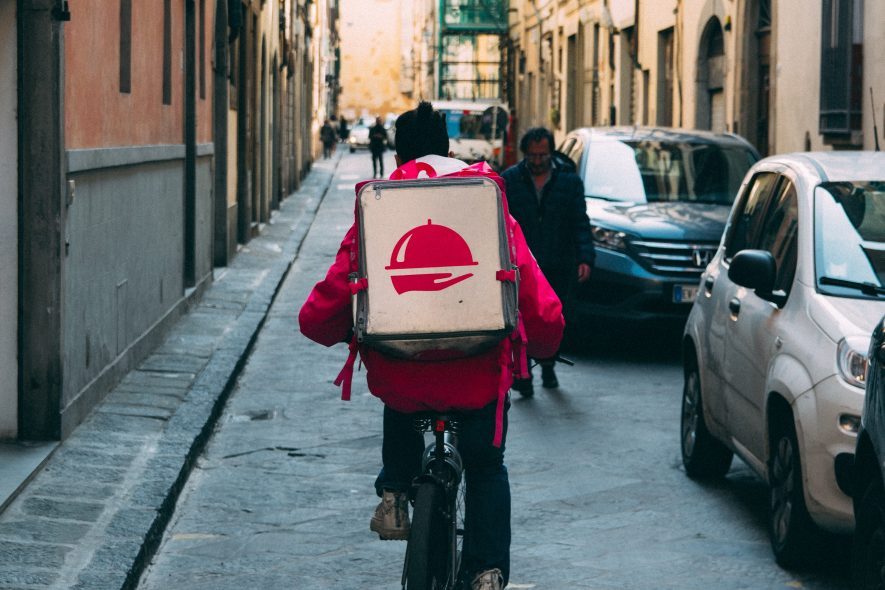
All-in-One POS
Nōwn gives you the only customer recognition POS platform with the tools that help you know your customers – and keep them coming back.
Learn more about the features
The State of Third Party Delivery Today
It is a fantastic time to be alive for people who don’t want to venture beyond their living room. Why? because the internet has everything you might ever need. The dog ran out of kibble? Amazon Prime. Nothing to do? Netflix. Don’t feel like cooking? Uber Eats, Door Dash and SkipTheDishes will deliver a whole city’s worth of culinary experiences right to your door for you to devour in the comfort of your living room. In the age of anywhere delivery, we now expect to have everything couriered to our doors with a few taps on our phones, no matter what the product is.
The convenience of summoning prepared meals to your doorstep has third-party food delivery use growing at a dizzying rate. Online platforms have revamped the delivery market that was once only for pizza and Chinese restaurants, into a huge new source of sales for restaurants of all kinds. The merging of third-party delivery apps with sit down and takeaway restaurants are reshaping the restaurant industry.
Dining In is the New Eating Out
Between 40 hour a week jobs, commutes, kids, pets and attempting to fit a social life into the mix, it doesn’t leave much time for much else. Especially cooking. The combination of being strapped for time and expecting convenience from the “on demand age” has made ordering food through delivery apps a part of people’s lifestyles. From what was ‘nice to have’ is now a ‘must have’. But this convenience does come at a price, both to diners and restaurants themselves. There’s a delivery fee — $5.00 to $7.50 is the common delivery charge. On top of that, you are still supposed to tip drivers which can all add up quickly if you’re a frequent user of delivery apps. Despite the high costs, people are more than willing to pay for the cost of convenience. Convenience — isn’t that what being in the hospitality industry is all about?
The Downsides of Third Party Delivery
The idea of third-party delivery seems very appealing. You can sign up online and instantly offer delivery to your customers without the work and expense of having to hire, train and pay drivers. Despite the seemingly easy arrangement, many restaurateurs have become annoyed with the fees charged by delivery services. Delivery companies charge from 15 to 30% per order for delivery services. Some restaurants have even had to mark up meal prices on the apps to be able to make any profit at all. A recent New Yorker article covered this issue in NYC, where a restaurateur said her overall profit margin had “shrunk by a third”, which she attributes to the high delivery app fees.
There’s more for restaurants not to like. On top of the high fees, Delivery Apps create serious logistical headaches for restaurants. Customers become frustrated if their order arrives late or if the food arrived cold or sometimes, upside down or even not at all. Instead of customers blaming the delivery service for their order, they’ll blame the restaurant and may even write a bad review online.
Some Restaurants are Opting Out Third Party Delivery
The most vocal restaurant against the third-party delivery is US sandwich chain Jimmy John’s. They came out publicly via an ad campaign where they called out delivery apps and vowed to never use them because they are so “notoriously unreliable”. Domino’s CEO has also been vocal about their grievances against third-party delivery, saying keeping delivery in-house helps them maintain higher food quality and control costs. Other large chains have rejected third-party delivery after testing it out, including Panera Bread and Olive Garden. While in-house delivery is obviously ideal for restaurants who want to keep control, the task of having to hire more staff and source vehicles can be a tall order for smaller businesses.
Delivery is Here to Stay
Third party delivery companies like Skip The Dishes and Foodora are rewriting the restaurant rulebook, for better or worse – and they’re not going away anytime soon. Whether restaurant owners like it or not, the relationship between the younger generations and these companies is getting stronger. Delivery apps and other digital innovations that consumers now expect are redefining the market, adding largely to the revenues of some businesses while others who refuse to adapt will miss the boat.